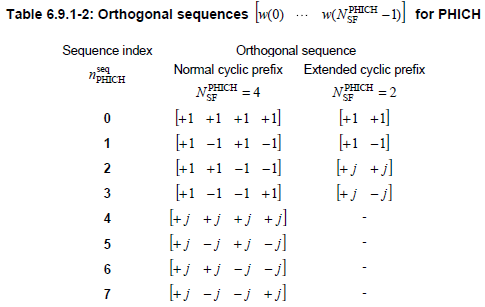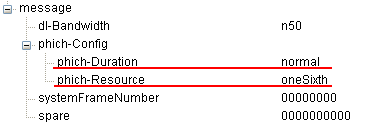PHICH
stands for Physical channel HybridARQ Indicator Channel. Simply put, it
is a secially designed downlink only channel which carries ACK or NACK
for the PUSCH received by the network.
Uplink
case they just used PUCCH for carrying ACK/NACK for each PDSCH it
recieved. Why don't we use PDCCH for ACK/NACK on network side. Good
topic for you to think over -:)
- PHICH is carried by the first symbol of each subframe. (It is located in the same symbol as PCFICH).
- One PHICH is carried by multiple REG.
- Multiple PHICH can be carried by the same set of REG and these multiple PHICH being carried by the same REGs are called PHICH group. These multiple PHICHs are multiplexed by orthogonal codes.
- Therefore, to indentify a specific PHICH we need to know PHICH group number and orthogonal code index.
In
some (many ?) cases, mutiple PHICH can be mapped to a same set of
resource elements and this group of PHICH being carried by the same set
of resource element is called PHICH Group. (Why we have to carry
multiple PHICH on a same set of resource elements ? Another good items
for you to think -:) ).
When
some "multiple things" are carried by the same physical resources, we
call the multiple things being "multiplexed". So we can say a group of
PHICH is being 'multiplexed' onto a set of resource elements.
When
you multiplex something, you always have to think about how to
"de-multiplex" them. It means that you have to multiplex somethings in
such a way that they can be easily separated into individual things. If
you multiplex things and those things cannot be demultiplexed, it is
called a garbage -:).
One
of the most common way of multiplexing in wireless communication would
be to use "orthogoal sequences". (You may remember how they multplexed
multiple set of data in CDMA or WCDMA). PHICH multiplexing also uses the
same method, meaning they are multiplexed with a set of predefined
orthogonal sequences. The set of orthogonal sequence defined in 3GPP
36.211("6.9 Physical
hybrid ARQ indicator channel") is as follows.

You may notice that the PHICH spreading factor for 'Extended cyclic prefix' is half of the one for 'Normal cyclic prefix'.
As
a summary, I will put down the definition of PHICH and PHICH group is
defined in 3GPP 36.211 "6.9 Physical hybrid ARQ indicator channel" as
follows.

You
would quickly notice that number of PHICH group is twice as many for
extended cyclic prefix as the one for normal cyclic prefix.
You
would see that to calculate the N_group_PHICH you should know Ng value
and the specification says the Ng value comes from higher layer. In this
case, the higher layers means "MIB (Master Information Block)". MIB has
an IE(information element) called "phich-Resource" as shown below. This
IE represents Ng.

How
many PHICHs can be carried by one PHICH group ? Maximum 8 PHICHs can be
multiplexed into a PHICH group when we use normal CP and Maximum 4
PHICHs can be multiplexed into a PHICH when we use the extended CP. Zero
PHICH in a PHICH group is also allowed.
How
many PHICH groups can be supported by a system bandwidth ? This can be
determined by the system bandwidth (N_RB) and a special parameter called
Ng. These N_RB and Ng value is carried by MIB as shown above.
With
Ng and the N_DL_RB (maximum number of RB for a system bandwidth), you
can calculate the N_group_PHICH as in the following table.
N_RB \ Ng
|
1/6
|
1/2
|
1
|
2
|
6 (1.4 Mhz)
|
1
|
1
|
1
|
2
|
15 (3 Mhz)
|
1
|
1
|
2
|
4
|
25 (5 Mhz)
|
1
|
2
|
4
|
7
|
50 (10 Mhz)
|
2
|
4
|
7
|
13
|
75 (15 Mhz)
|
2
|
5
|
10
|
19
|
100 (20 Mhz)
|
3
|
7
|
13
|
25
|
Each PHICH in a PHICH group is mapped to each UE.
How
many REG would be required to carry one PHICH ? To figure this out, we
have to go through several steps and do some mental calculation.
i) ACK and NACK is encoded by 3 bits (111 for ACK, 000 for NACK).
iii)
According to Table 6.9.1-2 of 36.211, each bit of PHICH is spreaded by 4
bits (SF=4) when we use 'normal cyclic prefix'. So each PHICH after
spreading with a 4 bits orthgonal sequence becomes 12 bits.
iii)
PHICH is modulated in BPSK and this means 'one symbol carries one bit'.
And this in turn means we need 12 symbols for each PHICH (each ACK or
NACK).
iv) Each RE (Resource Elements) carries one symbol. So we need 12 REs to carry one PHICH (one ACK or NACK).
v) one REG is made up of 4 REs. So we need 3 REGs to carry one PHICH.
vi) These three REGs for one PHICH is distributed evenly across the whole bandwidth.
From
those multiple Groupes in a system bandwith and multiple PHICHs within
each PHICH group, how UE would know exactly which PHICH to look for ?
For the very details, you have to understand the procedure described in
9.1.2 PHICH Assignment Procedure of 36.213. As I mentioned above, you
have to know the PHICH group number and orthogonal sequence index to
locate the specific PHICH. UE figure
out these two numbers from the lowest PRB index of the first slot of the
PUSCH transmission and DMRS cyclic shift.
How many PHICH groups are supported in a system? That depends on the specific configuration. The actual number of PHICH groups can be derived from the downlink bandwidth and the parameter (Ng), both of which are broadcast in the Master Information Block (MIB). The formula is defined in 3GPP TS 36.211 section 6.9 as shown below. Assume that the downlink channel bandwidth is 10 MHz and that Ng = 1; in this case, there will be a total of 7 PHICH groups available. The total number of PHICHs supported per subframe would then be 7 PHICH groups x 8 PHICHs per PHICH group = 56 PHICHs. The total number of resource elements (REs) needed is 7 PHICH groups x 3 REGs per PHICH group x 4 REs per REG = 84 REs.
We know that each PHICH carries HARQ ACK/NACKs for uplink data transfers. How does a UE know where to look for its PHICH? In the time domain, if the uplink transmission occurs in subframe n, the corresponding PHICH will be in subframe n+4. In the frequency domain, it is indicated by the uplink resource allocation with DCI format 0, where the specific PHICH (PHICH group number, orthogonal sequence index within the group) is derived from the lowest uplink PRB index in the first slot of the corresponding PUSCH transmission and the DMRS cyclic shift. For details on this calculation, please refer to 3GPP TS 36.213 section 9.1.2.
No comments:
Post a Comment